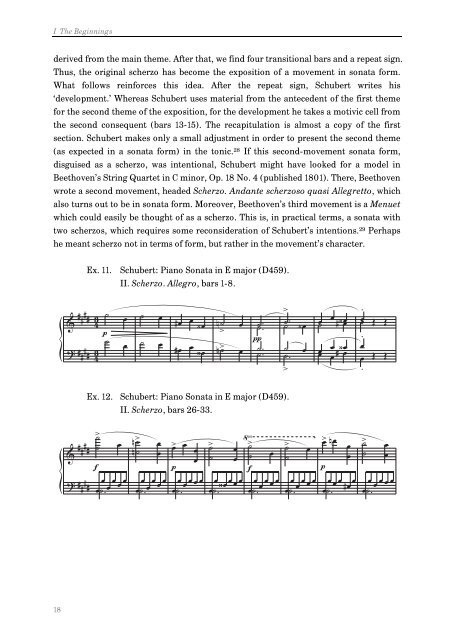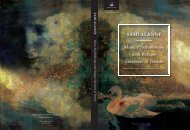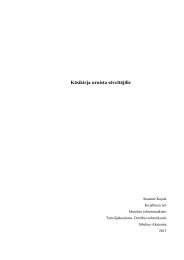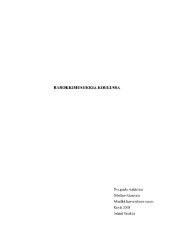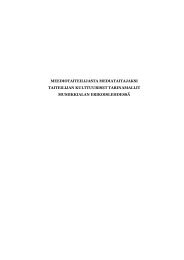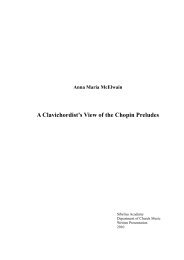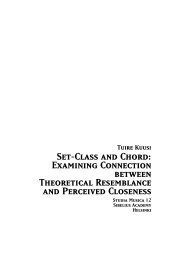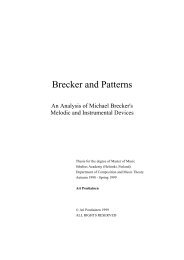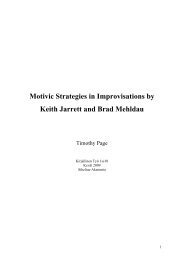The Unfinished Piano Sonatas of Franz Schubert Javier ... - Ethesis
The Unfinished Piano Sonatas of Franz Schubert Javier ... - Ethesis
The Unfinished Piano Sonatas of Franz Schubert Javier ... - Ethesis
You also want an ePaper? Increase the reach of your titles
YUMPU automatically turns print PDFs into web optimized ePapers that Google loves.
I <strong>The</strong> Beginnings<br />
derived from the main theme. After that, we find four transitional bars and a repeat sign.<br />
Thus, the original scherzo has become the exposition <strong>of</strong> a movement in sonata form.<br />
What follows reinforces this idea. After the repeat sign, <strong>Schubert</strong> writes his<br />
‘development.’ Whereas <strong>Schubert</strong> uses material from the antecedent <strong>of</strong> the first theme<br />
for the second theme <strong>of</strong> the exposition, for the development he takes a motivic cell from<br />
the second consequent (bars 13-15). <strong>The</strong> recapitulation is almost a copy <strong>of</strong> the first<br />
section. <strong>Schubert</strong> makes only a small adjustment in order to present the second theme<br />
(as expected in a sonata form) in the tonic. 28 If this second-movement sonata form,<br />
disguised as a scherzo, was intentional, <strong>Schubert</strong> might have looked for a model in<br />
Beethoven’s String Quartet in C minor, Op. 18 No. 4 (published 1801). <strong>The</strong>re, Beethoven<br />
wrote a second movement, headed Scherzo. Andante scherzoso quasi Allegretto, which<br />
also turns out to be in sonata form. Moreover, Beethoven’s third movement is a Menuet<br />
which could easily be thought <strong>of</strong> as a scherzo. This is, in practical terms, a sonata with<br />
two scherzos, which requires some reconsideration <strong>of</strong> <strong>Schubert</strong>’s intentions. 29 Perhaps<br />
he meant scherzo not in terms <strong>of</strong> form, but rather in the movement’s character.<br />
18<br />
Ex. 11. <strong>Schubert</strong>: <strong>Piano</strong> Sonata in E major (D459).<br />
II. Scherzo. Allegro, bars 1-8.<br />
#<br />
& #<br />
# #<br />
4<br />
? # #<br />
# #<br />
3<br />
4 3<br />
˙ œ<br />
p<br />
˙ œ<br />
˙ œ<br />
˙ œ<br />
# œ<br />
# œ<br />
œ<br />
œ<br />
‹ œ<br />
‹ œ<br />
n ˙<br />
><br />
œ<br />
n ˙ > œ<br />
˙ .<br />
π<br />
˙<br />
.<br />
Ex. 12. <strong>Schubert</strong>: <strong>Piano</strong> Sonata in E major (D459).<br />
II. Scherzo, bars 26-33.<br />
> ˙<br />
˙<br />
#<br />
& #<br />
# #<br />
f<br />
? # #<br />
# #<br />
œ<br />
œ œ œ œ œ œ<br />
˙ .<br />
n > ˙ œ<br />
n ˙ œ<br />
œ œ œ œ œ œ<br />
˙ .<br />
œ> œ œœ<br />
p<br />
œ œ œ œ œ œ<br />
˙ .<br />
√<br />
> ˙<br />
œ<br />
˙<br />
œ<br />
œ œ ‹ œ œ œ œ<br />
> ˙<br />
˙ œ<br />
˙ .<br />
œ œ œ œ œ œ<br />
f<br />
˙ .<br />
><br />
˙<br />
.<br />
‹ œ<br />
˙<br />
œ<br />
.<br />
><br />
> ˙ œ<br />
˙<br />
œ œ œ œ œ œ<br />
˙ .<br />
œ œ<br />
˙ # ‹ œ<br />
œ œ ‹ œ<br />
œ œ # œ<br />
œ> n œ<br />
œ<br />
œ<br />
œ œ œ œ # œ<br />
œ<br />
p<br />
˙ .<br />
œ .<br />
œ<br />
œ .<br />
œ<br />
.<br />
Œ Œ<br />
Œ Œ<br />
> ˙ œ<br />
˙ œ<br />
œ œ œ œ œ œ<br />
˙ .


